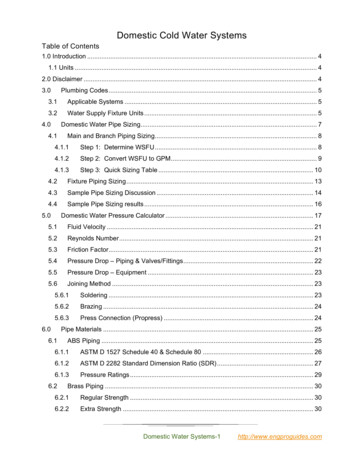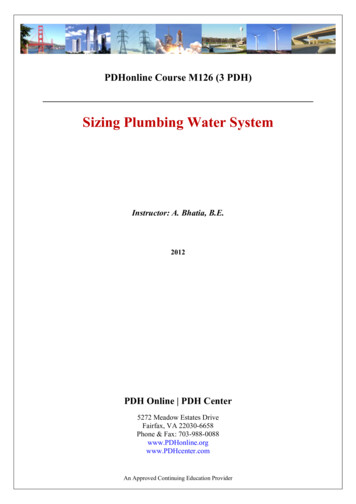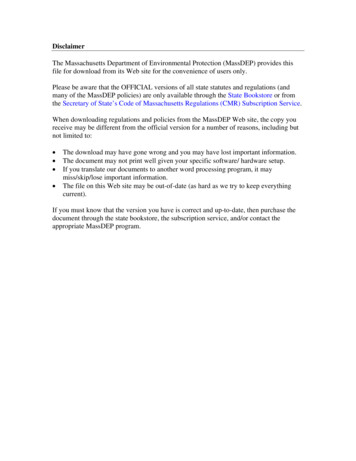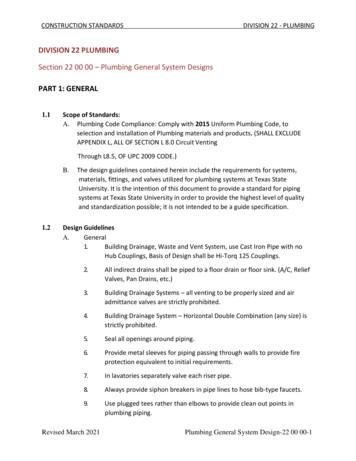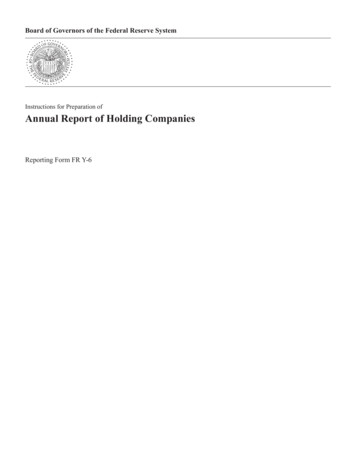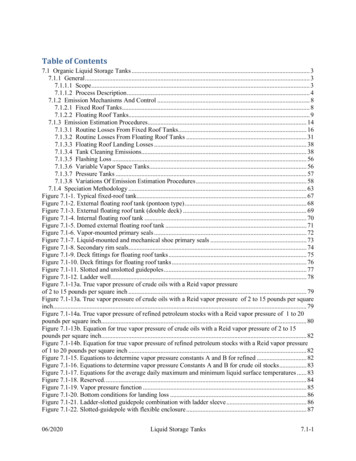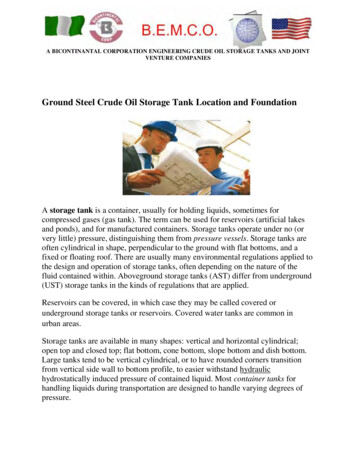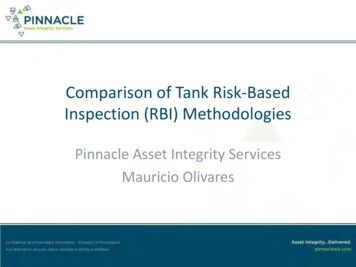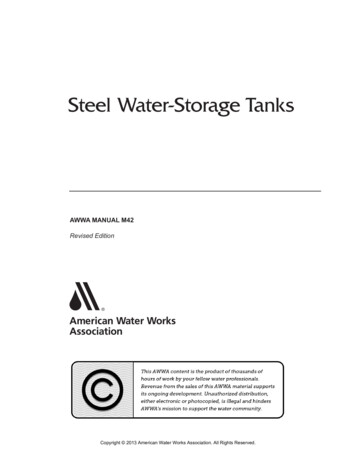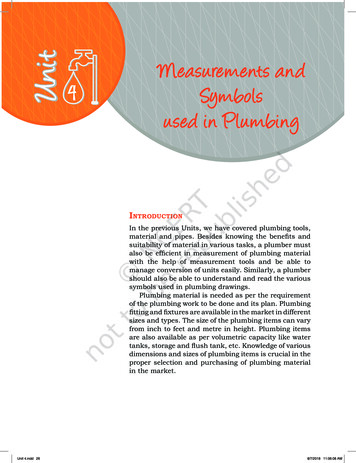
Transcription
From the Editors ofHolding Tanks, Plumbing,and Odor ControlMarine Sanitation SystemsVolume Two
Table of ContentsEditorsDarrell NicholsonAnn KeyPublisherTimothy H. coleEditorial Offices7820 Holiday Dr. S., Suite 315, Sarasota, FL sailor.comCustomer Servicewww.practical-sailor.com/customer serviceChapter 1: Sanitation System PlumbingSanitation Hoses · Hose Installation Notes · Manufacturers’ Advice ·Y-valves Bench Test · Y-valves Installation Advice · Plumbing OptionsPage 3Chapter 2: Holding Tank TestPage 14Chapter 3: Holding Tank SensorsPage 16Chapter 4: Controlling Head OdorsPage 23Chapter 5: Maintaining A Healthy SystemPage 33Contacts DirectoryPage 34Sealand vs. TrionicExternal Tank Sensors · Internal Tank Sensors · Long-term Test ResultsWaste Vent Filters · Proper Vent Installation · Holding Tank Treatments ·Inline DeodorizersPractical Sailor (ISSN #0161-8059) Marine Sanitation Systems e-book is published by Belvoir Publications Inc., 800 Connecticut Ave, Norwalk, CT06854-1631. Copyright 2012, Belvoir Publications, Inc. All rights reserved. Reproduction inwhole or in part is strictly prohibited.Contact information, product availability, and product specifications included in this e-book may have changed. We recommend supplementing this report with online research or calls to themanufacturers to ensure that you have the most up-to-date information when purchasing any products. 2 PRACTICAL SAILOR Marine Sanitation Systems www.Practical-Sailor.com
Chapter 1Sanitation System PlumbingSanitation Hoses Hose Install Notes Manufacturers’ Advice Y-valves Bench Test Y-valves Installation Advice Plumbing OptionsWe’ve often fantasized about the invention of some scientific doodad that could make waste disappear with thepush of a button or at least transmogrify it into somethinguseful (such as biodiesel or gold doubloons). Until that happyday arrives, sailors will continue to have need of a reliableway to collect and store waste until it can be properly disposed of.What follows are our bench test results on everything fromholding tanks to diverter valves, as well as some tried-andproven tips for controlling head odors and properly maintaining your system.Sanitation HosesThere simply is nothing like the smell of the sea. Unfortunately, the smell of a boat with defective sanitation hose isnothing at all like that.Sanitation hoses are specifically designed to contain odorousgases. They are made of very different materials than the manysimilar-looking hoses used for fuel, coolant, and tap water—and they are not interchangeable.In September 2000, Practical Sailor reported on our hosepermeation study, which used carbon disulfide as a surrogatefor sewage to test for permeation and other signs of deterioration. SeaLand’s OdorSafe Plus hose was the clear winnerin that test, but a few synthetic-rubber hoses known toprovide good service failed. One, Trident 102, is known tobe dependable, and the maker claims there’s never been adocumented failure with it in over 15 years. Hose makerShields was similarly surprised with its hose’s failure.Since carbon disulfide is used as a solvent in the production of rubber, was this test somehow unfair or irrelevant?Much as a pure oxygen atmosphere can cause metals toburst into flame that would never burn in atmosphericoxygen, did the use of a single chemical cause failuresthat were not real?Practical Sailor repeated the test using diluted chemicalin place of sewage and by using vapor only, but the resultswere similar. We never were able to establish a correlationbetween the test bench results using synthetic waste andthose using real waste in the field.One year ago, we launched a new round of long-termwaste hose testing. This time, we decided to use actual www.Practical-Sailor.com sewage, the waste of a 20-pound iguana. This article will lookat the various hoses and materials we’re testing, and the ValueGuide offers our preliminary results after one year.A Look at Hose MaterialsThe builder of PS tester Drew Frye’s catamaran, PDQ Yachts, hadthe good sense to place the holding tank and all of the sanitationhoses in a bulkhead compartment, sealed off from the rest ofthe boat. Unfortunately, someone also had the poor sense to useclear vinyl hose for the vent lines, which didn’t resist permeationat all, turning yellow and stiff and sticky with a foul surfaceresidue. They also used ordinary reinforced exhaust hose forthe sewage and pump-out lines; these didn’t fair much betterthan the clear vinyl.Over time, a brown residue formed on the surface, and thewhole compartment became foul to the point where retrievingthe fishing poles stored there became quite an unpleasant task.It seems a reinforced fuel or coolant hose, no matter how wellbuilt, simply can’t contain the stink of stagnant sewage. Giventhree to five years, the odors simply go right through the wall(permeate), and the boat becomes unlivable.In a home, sewage is contained by metal and polyvinyl chloride (PVC) pipes—completely impervious to permeation—butthese rigid materials usually are not practical on a boat, given thefitting and flexing challenges a marine installation presents. Asit turns out, achieving long-term resistance in a flexible productTrident 102Rubber exhaust hoseShields Poly-X PRACTICAL SAILOR Marine Sanitation Systems 3
Suspending a 1-pound, ball-peen hammer from the end of a hoseis a simple but effective test to measure hose stiffness.rylonitrile butadiene rubber hose; Raritan’s butyl rubber Sani/Flex Odor Shield; and Shields Marine’s Poly-X polyurethanesanitation hose.For comparison, we also tested schedule 40 PVC sanitationpipe and clear vinyl hose made by Trident. PVC pipe was selectedas a material known to resist permeation indefinitely, while clearvinyl hose was selected as a material expected to fail and as aproduct that is occasionally found in marine sanitations systemswith universally disappointing results.How We Testedis a real challenge.Instead of nitrile and neoprene—the material of choice for fueland exhaust hose—boat owners should look at urethane, butyl,EPDM, and PVC hose for sanitation systems.Why isn’t PVC pipe, vinyl tubing, or vinyl hose the best choice?Because PVC pipe is rigid, and vinyl hose is softened by addingplasticizers; on a chemical level, these have the effect of leaving theplastic porous. The softer the formulation, the faster acid gases likehydrogen sulfide and carbon disulfide seep through. Soft vinyl tubing fails in months and is included in this test only as a referencepoint. The vinyl sanitation hose in the test (SeaLand OdorSafe Plus)is very stiff, contains much lower levels of plasticizers, and containsother polymers that help block odors; a hybrid product of sorts.This is a necessary compromise, aimed at delivering the requiredpermeation resistance with adequate flexibility.Butyl rubber is known for very low gas permeation rates—it’s beenused for inner tubes for many years and even today, all tubeless tiresuse a laminated butyl rubber liner to control air loss—but it doesn’thandle oils well at all. Of course, sanitary waste doesn’t contain oil,and when used properly, head lubricants are too limited in volumeto be an issue. However, disposing of any oil or solvent in the heador placing oils in a head plumbing system in a manner where theywill be in the hose or head for any period of time is likely to damageany sanitation hose and elastomers in the head itself.EPDM is a common choice for steam hoses and is used in highend engine coolant hoses because of its low permeation rates withhot water and glycol (antifreeze). It resists acids and bases well, buthas a weakness regarding oil.Polyurethane has a good combination of chemical resistances andalso resists oil. However, air and steam permeation rates are higherthan butyl and EPDM, respectively. It is common in hoses used byhoney dippers. Whether it resists sewage well, we will see. Wastehose maker Shields has combined this with other polymers into acomposite hose, an approach that is common in chemical hoses.What We TestedWe tested flagship sanitation hoses from four of the market’sleading manufacturers. The test field included Trident Marine’s101/102 EPDM hose; SeaLand’s OdorSafe Plus, a PVC and ac 4 PRACTICAL SAILOR Marine Sanitation Systems To mimic real-world conditions, we created a series of six miniature holding tanks—5-gallon buckets with lids—containingsanitary waste supplied by a 20-pound, 5-foot iguana. Seawaterwas used to “flush” the tanks, as the odor problems are knownto be more severe with seawater-flushing systems, the result ofbacteria reducing sulfate into more odorous chemicals.These are the same holding tanks we’re using for the longterm waste vent filter test (see chapter 3). Testers used 3/4- to5/8-inch hose fittings, as required by each vent filter design. A4-inch PVC filling standpipe with valve was used to fill eachtank with 1 gallon of sewage every five days (effluent plus seawater). The holding tanks were dumped each time they reached80-percent capacity.A hose was attached to the bottom of each holding tank, sothat it is continuously filled with sewage. Although having hosesfully submerged in sewage is contrary to the installation adviceof every hose maker, they agreed that the method was a soundway to force failure and is something they use in their own testing programs. None of the manufacturers consider their hosesto be permeation “proof” and recognize that permeation willeventually occur, if sewage sits in the hose continuously.Proper installation of sanitation hose includes sloping all linestoward the holding tank, and proper head operation includespumping enough water after the sewage to clear the line. Weignored this advice to force failures.We also tested hose flexibility. Manufacturers give minimumbend radius limitations for hose, but just what the ratings meanis unclear. Different makers rate the allowable radius bends atdifferent temperatures, and it’s not always specified whether thenumber indicates where kinking begins, the farthest it can bepressed, or is simply a “good practice” value.To determine uniform measurements for radius limitations,we devised two tests, both performed at 65 degrees. (See resultsin the accompanying Value Guide.) To measure stiffness, weclamped a 1-foot section of the hose being tested to the edge of aworkbench, suspended a 1-pound weight from its end, and measured the vertical deflection after 10 seconds. This gave testers anidea of the hose’s relative stiffness and workability. To measurebend radius, we took a length of test hose and pressed it untilit showed signs of buckling. Some were very difficult to bendto that threshold, most notably the SeaLand OdorSafe. RaritanSani/Flex, on the other hand, bends easily to its minimum radius www.Practical-Sailor.com
value guideManufacturerNamePrice / FOOT*sanitation hoses preliminary resultsRARITANSeaLandSHIELDSSani/FlexOdor ShieldOdorSafePlusPoly-XTRIDENT101/102 PVCClear vinyl**Schedule 40** 13 9.65 19.62 7.99 5.9945 Butyl rubberPVC andacrylonitrilebutadiene tationhoseSanitationhoseSanitationhosePotablewater hoseRigidpipeSIZE TESTED1.5-inch ID1.5-inch ID1.5-inch ID1.5-inch ID1.5-inch ID1.5-inch IDcommentsCan kink if forcedbecause it isso flexible.Very stiff;smooth surface;easy to cleanSmoothsurface; easiestto cleanDistinctiverubber smell;stains easilyBecomesyellow whenpermeationis severeSusceptible tofreeze damage;not flexibleMATERIALTest ResultsMinor (onlypresent inwipe test)Major(noticeableby smell)PERMEATION @ 6 MONTHSNoneNoneNoneNonePERMEATION @ 12 MONTHSNoneNoneNoneNoneSTIFFNESS(DEFLECTION @ 65 DEGREES)4.25 inches0.21 inches0.56 inches1.25 inchesNot measured;limp0.1 inches7 inches20 inches12 inches11 inchesNot measured;kinks easilyNot applicableU-TURN RADIUS(@ 65 DEGREES)Best Choice Budget BuyRecommendedbut would be ruined if pushed hard.The stiffness values will certainly be less at warmer temperatures—based on our experience working with these inhot weather—but the minimum bend radius will not be muchdifferent. The rubber hoses were softened slightly by warmertemperatures and stiffened slightly in cooler temperatures, buttemperature seemed to affect the OdorSafe hose the most significantly. It rapidly stiffened below 60 degrees in testing, was notworkable at 50 degrees, and was effectively rigid at 40 degrees.Conversely, it softens rapidly with heat, and on a 90-degree day,it would be comparable to a stiffer rubber hose. However, addingheat to gain flexibility is not recommended by the manufacturer;the hose can be weakened and more prone to kinking.When it comes to waste hoses, there is only one true measureof effectiveness: whether the vent stinks when the head is flushed.However, as much as we might like to have calibrated noses andcompared the relative foulness of the products, it wasn’t possible.Instead, we sought a quantitative figure for direct comparison byusing a hydrogen sulfide monitor (like those used to test sewergas) to back-up our sniff testing.At regular intervals, the hoses were tested as follows: Eachmonth, each hose was wrapped in aluminum foil and sealed forone week. The fittings were not in the wrapped section, to avoidany contribution from potential leaks. The hydrogen sulfide detector was inserted under the foil and a reading was taken. Thiswas followed by a sniff test. At the end of the test period, eachhose was wiped with a damp cloth and the cloth sniffed. Eachhose also was observed for changes in appearance. www.Practical-Sailor.com NoneNone*Prices may vary, depending on retailer. ** Only tested as reference.During this initial test period (one year), none of the sanitation hoses permeated enough sulfide for the gas to be detectedor for any odor to be perceived under the wrapping. However,after four to six months, the clear vinyl hose did fail the wipe test.Testers will continue with the testing for the next severalyears to determine which product is the best, most durable wastehose for onboard use. We want to emphasize that the ratingsand recommendations at this point are only preliminary; lookfor followup reports in future issues.SeaLand OdorSafe PlusThe lone PVC-based sanitation hose in this test, SeaLand’s OdorSafe Plus, is a well-respected but very stiff hose. In some cases,we had to gently warm the hose (but not so much that it couldnot be held) and fitting to get it to slide on the barb; this was notrequired with any other hose. For this reason, the manufacturersells a special silicon hose lubricant and recommends the use ofits special smooth hose adapters in place of traditional barbs.The hose’s smooth finish is easy to clean, and of the hoses wetested, it looks the best for exposed runs. The OdorSafe, whichout-performed all others in the previous test using synthetic odor,is performing well at the one-year mark in this test, with no signsof permeation. It is available in 1½ inch only.Bottom line: The stiff OdorSafe was very hard to fit in ourtest boat installation (see “Field Test Installation Notes”), but weexpect it to excel in permeation resistance. It would be a solidchoice for installations where space is not too tight. It’s Recommended at one year. PRACTICAL SAILOR Marine Sanitation Systems 5
When installing waste hose, it’s best practice to secure connectionswith two stainless-steel hose clamps.stallation and cleaning ease, the Poly-X gets the PS Best Choicepick at the one-year point in this long-term test.Raritan Sani/Flex Odor ShieldA very flexible hose, Raritan Engineering’s Sani/Flex Odor Shieldis much easier to fit than any other tested hose and had the lowestbend radius in this test, making it a good choice for installing intight spaces. However, do not be tempted to bend it to less thana 4-inch centerline radius, as kinking is surely possible. Cut andinsert a PVC fitting for really tight turns. Though some peopleare concerned that fittings can lead to blockages, that does notseem to be the common experience; the joker valve at the exitof the head is much smaller than the fittings, so anything thatcan be flushed will pass through the fittings to reach the tank.Odor Shield is available in 1 or 1½-inch.Bottom line: The jury’s still out on the durability of the OdorShield hose, a comparatively new product, but it is worth considering for installations where very flexible hose is a must. It isa Recommended hose after one year of testing.Trident 101/102The 101/102 from Trident Marine Systems is a premium hosewith a proven track record; we have not heard of a single documented case of permeation issues using this hose. The Trident101/102 rated in the middle of the pack for stiffness, and testershad no difficulty fitting it in our test bench and test boat installations. However, testers did find the white hose significantlyprone to picking up dirt and minor staining, but this would onlybe an issue for the most fastidious plumber.Testers also noted that it has a very distinctive and slightlyacrid “new rubber” smell that lingered for 12 months, but it wasonly noticeably strong—even in a small compartment—for abouta week. Would this bother someone with a sensitive sniffer? Wedon’t think so; it’s more like new car smell than something foul.The 101/102 is available in 1-inch, 1 ½-inch, and 1 7/8-inchsizes, but only 1½-inch is widely distributed.Bottom line: Well-known as a dependable product, the Trident 101/102 has held up so far in testing, was easy to install, andcan be found at an affordable price. It gets the PS Budget Buypick at the one-year mark.Shields Poly-XThe Shields Marine Poly-X sanitation hose is another well-respected product, with a perfect track record, but high qualitycomes at a high price with the Poly-X. It was the most expensivehose we tested, costing nearly twice the price of the other hoses.On the other hand: It has no odor of any sort, resists dirt andgrime, and was the easiest of the test field to clean. Only slightlyless stiff than the OdorSafe, the Poly-X was surprisingly not difficult to push onto fittings in our test installations.It is available in 1-inch and the widely distributed 1½-inchsizes.Bottom line: With a good reputation and high marks for in 6 PRACTICAL SAILOR Marine Sanitation Systems Trident Clear vinyl hoseTrident Marine’s clear vinyl hose is soft and easy to work with,but it began to permeate within four to six months and in a fewtest installations (vent plumbing), it often kinked after install,sealing off the vent. Our experience lends us to believe that itwill continue to stiffen and permeate very badly, even in ventapplications.We want to be clear that Trident never recommended its clearvinyl hose for application in marine sanitation systems, so itsfailure should not be interpreted as a criticism of Trident. Weknew the clear vinyl would fail, and we included it in the testsolely for comparison of various hose types. In fact, every brandof vinyl hose we encountered during this test was yellowed andbadly permeated.We recommend Shields 148 or equivalent white vinyl sanitation hose for vent applications, as they will serve well in this dutyand are available in smaller sizes.Bottom line: Clear, soft vinyl tubing—in any brand—has noplace in sanitary waste lines or vent lines.ConclusionsSo far in this test, no premium sanitation hose has shown signsof permeation, but we are only one year into the long-term testing, and we wouldn’t expect failures yet—except with the clearvinyl hose. The clear vinyl hose permeated within a few months;it has no place in marine sanitation applications.No hose connections leaked during the duration of the test,and none were overly difficult to seat on the hose barbs. In fact,all hoses held drip free under gravity pressure without clamping.The white vinyl OdorSafe Plus was very stiff and difficult todeal with but should make a solid installation choice for systemsinstalled in spaces that aren’t too restricted. Premium syntheticrubber hoses are considerably more flexible, but even within theclass, there are significant differences: The Raritan Sani/Flex www.Practical-Sailor.com
The test boat previously had exhaust hose installed in the wasteline.Odor Shield is quite flexible, but the Shields Poly-X and Trident101/102 hoses are quite stiff. Whether these construction differences have any bearing on permeation and durability is not yetknown. We recommend the Raritan for cramped installationsthat call for very flexible hose.We were impressed with all of the test products and believeall will contribute to be trouble-free, odor-free installations forsome time.After only a year of testing, we recommend the Trident 101/102as the budget pick. The easy to install, easy to clean—but pricey—Poly-X gets the nod for Best Choice.Hose Installation NotesWhile model holding-tank testing allows side-by-side comparisons, there’s nothing like on-the-boat testing to sort out practicaldifferences. Our test boat, a PDQ 32, had been plumbed with amix of low-end vinyl sanitation hose and water exhaust hose;the rubber hose was permeated, cracked, and discolored, andthe sanitation hose was permeated to the point of having a thinfilm of sticky goo that had condensed on the external surface.A textbook case of time showing the weaknesses of poor material selection.Testers re-plumbed the sanitation system using pieces of eachhose type reviewed in this article. We’ll see how they hold up.Because they are not in identical exposures, the field test won’t offer direct apples-to-apples comparisons of permeation resistance.However, we did learn a few things about the hoses’ installationdifferences.Head to tank: We used Shields Poly-X here because it appearedto be the toughest hose that would make the bends. As with manymarine head installations, there is a hose bend leaving the head,and the SeaLand OdorSafe Plus hose had no chance of makingthe turn. As it was, we put a slight kink in the hose trying to forceit into the previous tie-down locations. We ended up workingthe kink out and moving the tie-downs a few inches. This hoserequired a bit of pressure to slide on the fittings, but no lubricantwas needed, and it sealed up nicely.Holding tank to vent: We chose fabric-reinforced clear vinyltubing, so that we could see what was going on. Since this boatis also a test bed for holding tank vent filters, we wanted to beable to monitor overflow behavior and the water trap. The boathad been previously plumbed with the same tubing to the vent,and it was badly yellowed and permeated. Clear vinyl is easy towork with and very flexible, but it’s prone to collapse if bent evena little too sharply. In fact, after a few months of testing, the clearvinyl loop collapsed, and we replaced the section with Shields148 white vinyl sanitation hose, one of very few sanitation hosescommonly available in ¾-inch.Holding tank to Y-valve: We again chose Shields Poly-X. Itparallels the fill hose for part of the run, and this insured matching turns. www.Practical-Sailor.com Y-valve to pump-out: Petroleum tank truck hose was fittedhere two years ago and is doing fine, so we left it in place, forcomparison. It is most similar in fitting to Shields Poly-X.Y-valve to discharge pump: We used the Trident 102 here.The bend radius was long enough, and the hose slid on the fittings easily. The liner is soft enough to seal easily. Testers foundthe 102 to be a very solid hose that is a pleasure to work with.Discharge pump to seacock: We used the SeaLand OdorSafePlus here. This section was an easy run so hose stiffness was notan issue. However, we had to heat both ends to get the hose togo over the fittings, and the seacock end was still quite difficult.(Note: SeaLand does not recommend heating hoses.) Althoughthis hose was the most difficult to fit, testers noted that it wasprobably the best-looking in the test field, so the challenginginstall may be worth it for use in exposed locations.General observations & tester tips: We can easily see using more than one sanitation hose toplumb a boat, each serving where it fits best. It also seemed clearthat the head-to-tank, tank-to Y-valve, and Y-valve-to-pumpouthoses were the most deteriorated. Before you buy expensive hose, be certain it will make therequired bends. Check out the accompanying Value Guide toget an idea of each hose’s stiffness. Ambient temperature matters. All of these hoses were muchstiffer when the mercury dropped. We wouldn’t choose to tacklea hose fitting job when it’s colder than 70 degrees. Use a spaceheater on the boat, if necessary, in the winter. Flush a lot of clean water through the hoses first. PVC-coated palm gloves are a big help when muscling hosethrough bulkheads and onto fittings. They are also good for handling yucky old hoses. Glycerine is a good lubricant choice when trying to fit hoses.It’s compatible with all sanitation hose types and will eventuallyevaporate, leaving no slippery residue, unlike soap. Do NOTuse petroleum compounds on sanitation hose. EPDM and butylrubber sanitation hoses are very vulnerable to petroleum compounds and will be damaged. Do not use silicone caulk to seal hoses. It only makes a messfor the next time hoses are changed, and it increases the probability of leaks. If the hose is leaking, check the barb. Use two all stainless-steel hose clamps, 180 degrees apart,to shore up connections. Except for white vinyl hoses, all sanitation hoses are wire PRACTICAL SAILOR Marine Sanitation Systems 7
reinforced. The cut end of the wire is needle-sharp, so secureit under clamping bands to prevent a puncture-wound hazard.You can cut it off flush, but it’s safer to pull it out and secure it. Inspect the bulkhead pass-throughs and smooth as needed.You can seal the pass through with caulk to prevent motion andpossible chafing. Don’t cut the new hose to length based upon the old hose.The securing points and fit will change if you switch to a different hose type.Manufacturers’ AdviceBefore starting most tests, we like to interview the participatingmanufacturers. Below is a rundown of some advice we gleanedfrom the waste hose manufacturers. Hose routing: Always slope pipes and hoses toward theholding tank after the initial rise. Any hose will eventually permeate if sewage is left standing in it. If long runs are unavoidable,consider using well-secured Schedule 40 PVC pipe—not DWV(drain-waste-vent) PVC, which has thinner walls. Head operation: Always flush enough clean water to moveall the waste to the holding tank to prevent standing sewage. Antifreeze: PVC hoses are not compatible with glycol- oralcohol-based winterizing products. The glycol or alcohol canextract some of the PVC plasticizers, resulting in increased permeability and stiffness. Although the hose will not fail, it maypermeate. This does not apply to synthetic rubber hoses. Oil: Synthetic rubber hoses made of EPDM or butyl rubber may not tolerate large amounts of mineral or vegetable oil.However, small amounts of oil that may find their way into ahead as a result of owner maintenance practices should not beharmful. However, this is one more reason why greasing headpumps with heavy silicone grease at the start of each season is afar better practice than the often-suggested practice of flushing atablespoon of vegetable oil in the head. In fact, the vegetable oilwill only hasten the grease’s washout. This incompatibility doesnot apply to PVC, neoprene, or urethane hoses. Wipe test: If you suspect a permeated hose, scrub the hosearea clean, wait for several days and then wipe the suspect hosewith a damp cloth and sniff the cloth. If it is permeation, theodor will come back soon enough. Leaks: Although permeation is a common cause of hoseodor, it is by no means the only cause. Slow leaks around fittingsand hose clamps, and sewage that was inadequately cleaned upare also frequent causes; inspect the ends before assuming youhave a failed hose. A crooked clamp or scored barb often allowleaks that will not be cured by tightening a clamp. It is temptingto cure a leak by using a sealer (polyurethane or silicone caulk),but generally this is temporary and is very bad practice wheninstalling new hose. Instead, fix the problem. Hose connections: Barbs vs. smooth adapters. SeaLand,maker of the SeaLand hose brand, is a believer in smooth connections. Properly sized, the company claims, they are easier to use,seal better, and do less damage to the hose. This is particularlytrue with the stiff PVC hoses, like SeaLand OdorSafe Plus, which 8 PRACTICAL SAILOR Marine Sanitation Systems fits well enough on barbed fittings but is impossible to remove.For high-pressure applications, some type of contoured or barbedfitting is still generally recommended, though many hose makersnow specify rounded profiles. Not all fittings are a good match;if fit seems too loose, check with the hose maker. Hose lubrication for installation: A compatible lubricantcan be a big help in getting a hose installed correctly. Read thehose specs to be certain the lube is compatible. EPDM, for example, is not compatible with petroleum, so K-Y, glycol, or glycerineare better choices. Soap will work but can leave a non-dryingresidue that can interfere with a secure fit, particularly whenusing non-barbed fittings. SeaLand sells a silicone grease for usewith its hose. Sharp turns: Many sanitation hoses are quite stiff and don’tlike sharp turns; even if you can bend them to your will, it shortens their life. The manufacturers maintain that it is better to usea PVC elbow fitting as needed than to risk kinking a hose byforcing a turn. The fitting will be larger than the smallest passagein the toilet and should not create a problem. Fit the hoses a few inches long: Hose removal often involvesdestruction of the hose. Providing a few extra inches to play withwill simplify future repairs, rather like leaving halya
tank with 1 gallon of sewage every five days (effluent plus sea-water). The holding tanks were dumped each time they reached 80-percent capacity. A hose was attached to the bottom of each holding tank, so that it is continuously filled with sewage. Although having hoses fully submerged in sewage is contrary to the installation advice
